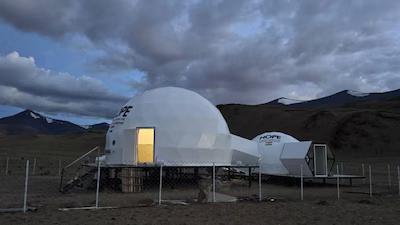
ISRO Sets Up Station in Ladakh to Simulate Life on Moon & Mars
In a significant step towards advancing India’s space exploration capabilities, the Indian Space Research Organisation (ISRO) has set up the Himalayan Outpost for Planetary Exploration (HOPE) in Ladakh’s Tso Kar Valley. The station is designed to simulate the harsh environment of the Moon and Mars, allowing scientists to test life-support systems for future lunar and Martian missions.
Located at an altitude of 4,500 meters above sea level, the Tso Kar Valley was chosen for its unique environment, which is eerily similar to that of Mars. The valley is characterized by high UV radiation, low atmospheric pressure, extreme cold, and saline permafrost, making it an ideal location for simulating the conditions on the Red Planet.
From August 1 to 10, two crew members will undertake various tests at the HOPE facility, which is expected to provide valuable insights into the challenges of living and working in extreme environments. The mission is a crucial step towards preparing for future human missions to the Moon and Mars, which are planned for the next decade.
According to ISRO officials, the HOPE facility is equipped with state-of-the-art equipment and technology to simulate the conditions on the Moon and Mars. The station is designed to test life-support systems, communication equipment, and other essential technologies that will be required for future space missions.
The valley’s extreme environment will also provide an opportunity for scientists to test the durability and performance of equipment and clothing designed for space missions. The data collected during the 10-day mission will be used to refine and improve the design of future space suits and equipment.
The HOPE facility is a significant achievement for ISRO, which has been working towards establishing a presence in the high-altitude regions of India. The agency has been conducting research in the region for several years, studying the effects of high-altitude environments on the human body and developing technologies to support future space missions.
ISRO’s plans for lunar and Martian missions are ambitious, with the agency aiming to send a manned mission to the Moon by 2024 and a manned mission to Mars by the mid-2030s. The HOPE facility is a critical step towards achieving these goals, providing scientists with a unique opportunity to test and refine the technologies and systems that will be required for these missions.
The HOPE facility is not just a testing ground for ISRO’s space missions, but also a symbol of India’s growing capabilities in space exploration. The agency has made significant strides in recent years, with the successful launch of several satellites and missions to the Moon and Mars.
In conclusion, the establishment of the HOPE facility in Ladakh’s Tso Kar Valley is a significant milestone in ISRO’s journey towards advancing India’s space exploration capabilities. The facility will play a critical role in testing and refining the technologies and systems required for future lunar and Martian missions, paving the way for India’s participation in the global space exploration community.






